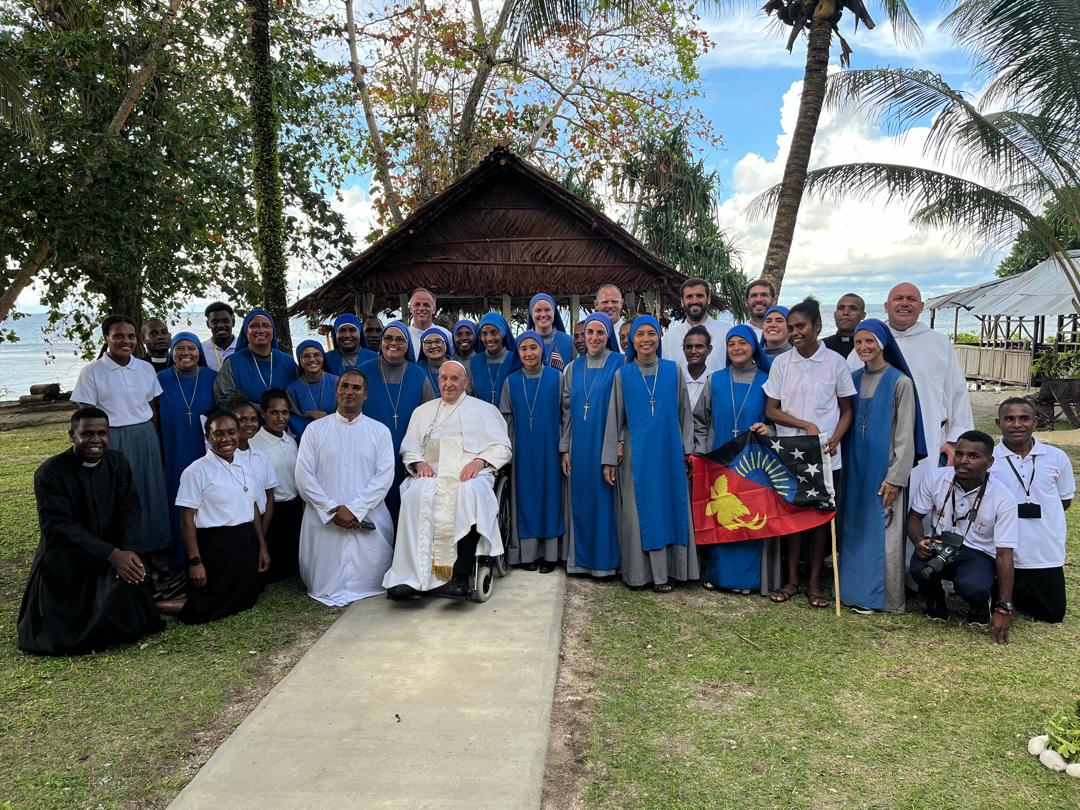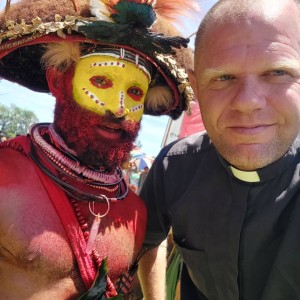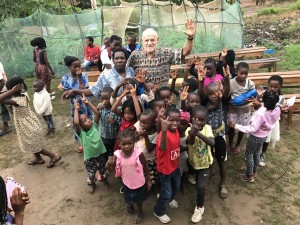
From the very beginning of his pontificate, Pope Francis was often described as the “world’s parish priest” due to his constant gestures of closeness toward the people he was called to shepherd as the 266th Successor of Peter.
This sentiment was widely shared — by the prisoners he visited on every trip abroad and in Rome during Holy Week, the patients and staff at Rome’s Gemelli Hospital during his four stays there, and the residents of Buenos Aires’ slums, where nearly every home had a photo of then-Cardinal Jorge Bergoglio or a prayer card featuring their fellow countryman.
But nowhere was this sentiment felt more strongly than in the world’s 1,124 mission territories — places where the Church is too poor to be self-reliant, where the Gospel is only now being introduced (giving new meaning to the term “new evangelization”), and where Catholics are persecuted for professing their faith. Pope Francis showed his priority for these territories every time he added a new stamp to his passport. With few exceptions — mainly for World Youth Day and the World Meeting of Families — his foreign trips were to places where the Church was both struggling and growing. In some cases, it was growing because it simply couldn’t shrink any further, as seen in Mongolia and Kazakhstan.
Through his travels and writings — beginning with Evangelii Gaudium, the carta magna of his pontificate — Pope Francis charted a roadmap for a missionary Church. He outlined the necessary waypoints to fulfill the Great Commission to “go and make disciples of all nations”: solidarity with the suffering, prayer that leads to action, interfaith dialogue that builds bridges, and the courage to enter conflict zones as peacemakers.
His essential message was clear: our eyes must be fixed on those who suffer, and every believer — not just “professionals” — is called to carry out the Church’s missionary work.
For a man who disliked traveling before being elected pope, Francis flew often: 44 trips, nearly 70 countries, second only to St. John Paul II — the “pilgrim pope” — in miles traveled. Yet one country many expected him to visit remained absent from his itinerary: his homeland, Argentina. His reasoning — whether simple or complex — remains a secret he took with him to the grave.
However, his love for Argentina was never in doubt, and it was especially evident in his ongoing support for Argentine missionary priests, whom he personally assisted both spiritually and financially, and with whom he kept in close contact.

Father Juan Gabriel Arias, an Argentine missionary priest who has long worked to bring the Joy of the Gospel to Mozambique.
Four examples are Father Gabriel Romanelli, parish priest of the Latin-rite Church of the Holy Family in Gaza; Father Juan Gabriel Arias, ordained for the Archdiocese of Buenos Aires but incardinated in Mozambique; Father Jorge Bender, a Franciscan; and Father Tomás Ravaioli.
Earlier this year, Pope Francis was hospitalized for almost 40 days, and updates beyond his health were rare. With one exception, which came on Ash Wednesday: the Holy Father called Argentine missionary Father Romanelli, pastor of the Holy Family Parish, the only Catholic parish in the Gaza Strip.
“As he did every day from the beginning of this terrible war, Pope Francis called us once again to show his closeness, to pray for us, and to give us his blessing,” Father Romanelli told us at the time. In a short voice message, the priest shared that it was “always comforting” to receive the call from the pontiff, especially knowing that “despite his delicate state of health, he continued to think of us and to pray for peace in Gaza.”
Father Arias served as a missionary in Mangundze, a rural village some 130 miles from Maputo, Mozambique’s capital, from 2014 until earlier this year, when he took a sabbatical to help welcome pilgrims in Rome during the Jubilee of Hope.
Darkness and silence in Mangundze are deafening. Electricity only arrived a year before the missionary, and things such as running water, paved roads, and four daily meals are the stuff of dreams. Yet he loved Mozambique: “There I am happy because there is so much to do. There was no priest when I arrived, and the parish had been abandoned. I feel useful here, giving a hand to people who live in extreme poverty.”
Like most missionaries, he became a man of all trades: the Gospel in one hand, ready to act as a doctor, mechanic, mason, or electrician.
“The Pope helped me financially, and I felt him close: every time I reached out to him — which was not often — he helped me, and that put me at ease when living in a place like this one,” Father Arias told us when Pope Francis was still hospitalized. “He was very present, always concerned for those who worked with the neediest. He knew me well, knew what I was doing and why I was there.”
The two met when Arias was a young seminarian and Francis was Bishop Jorge Mario Bergoglio. The future pope preached a retreat for the seminary of Buenos Aires, and the two clicked. Arias knew back then that he wanted to be a missionary working with those most in need. Though the Archbishop of Buenos Aires allowed him to be in Mozambique for three years, he summoned him back to Argentina’s capital to be a parish priest. It wasn’t until 2014, a year after the college of cardinals elected the first pope from the global south, that Arias moved permanently to Mozambique.
“When we first saw each other after that, he smiled knowingly at me and said: ‘You finally got away with it!’” Father Arias shared. The two met in Rome almost every year after that, where the missionary stayed at the Vatican’s Santa Marta residence where Francis lived. Ever since then, “every time I visited him, I never returned to Mozambique empty-handed. He was like a father to me when he was archbishop, and he remained a father to me as pope.”

Father Ravaioli, who has been in Papua New Guinea for the last 12 years, shared similar experiences of Pope Francis’ spiritual and material support: “He personally followed our mission for years. He wrote to us, by hand, asking how things were going and encouraging us. He also supported us financially, helping us build our secondary school and sustain our work in the jungle. He deeply desired to see our mission with his own eyes.”
The last time Ravaioli saw Pope Francis was in September 2024, when the pontiff made a stop in the middle-of-the-jungle mission station where the priest, along with a small community of missionaries from the IVE, is doing first evangelization — introducing the Gospel to a community of some 150,000 people for the first time.
“The Holy Father made it clear from the beginning that he didn’t just want to visit the capital; he wanted to come to Vanimo,” Father Ravaioli said. “That visit changed everything. It marked a before and after, not just in Vanimo, but for the evangelization of Papua New Guinea as a whole.”
Preparation for the Pope’s arrival was not merely logistical; it was a deeply spiritual process. “For months, we prepared our people, urging them to get ready not just materially but spiritually. We emphasized confession, Eucharistic adoration, and inner conversion. The vast majority of Catholics in the country went to confession before receiving the Holy Father. There was an incredible spirit of grace surrounding his visit.”
The Pope’s words during his time in Vanimo left an indelible mark. “Even today, no one has forgotten what he told us,” Father Ravaioli said. “His message continues to inspire us, pushing us to work even harder in our mission.”
And all because Father Ravaioli and his fellow missionaries had established a personal connection with Pope Francis.
Of the four missionaries, the one who knew Francis the longest is Father Bender, the seventh of twelve children. Bender first encountered Father Bergoglio when the future pope was rector of the Jesuit Seminary of San Miguel in Buenos Aires. Bender studied philosophy and theology there. “I remember him as someone who was very close, clear and laconic in his expressions, always pleasant.”
“Afterwards, life took us on different paths, but we met again in Buenos Aires — he as archbishop and I as the person in charge of the San Francisco Convent,” Father Bender shared.

Father Jorge Bender, with a group of children he helps on a daily basis. (Courtesy Father Bender)
When the missionary settled down in Mozambique, he would regularly share with Francis his experiences in “these spaces of geographical and existential frontier,” he said. “And he always answered me in his own handwriting, very kindly, very comfortingly.”
Though there isn’t much opportunity to listen to the pope’s weekly audiences or homilies in Mozambique, the Argentine pontiff — who visited the country in 2019 — “was very much loved. The simple people valued him dearly.”
“Personally, I feel that his proposal to live the Gospel is very challenging, and I am enthusiastic about this way of being and living in the Church,” Father Bender said. “A Church that goes out, with a priest who is not locked in the sacristy. St. Francis used to say that ‘our cloister is the world,’ and Pope Francis was a great proponent of this.”
Pope Francis never returned to Argentina, but his heart remained with his people — especially those serving in the world’s poorest corners. For him, missionary priests weren’t just men carrying out a duty; they were his spiritual sons, embodying the Church’s call to go to the peripheries.
Because of that, his missionary legacy will endure.


